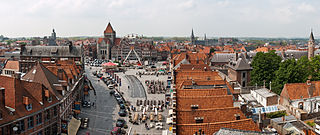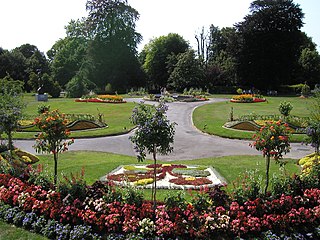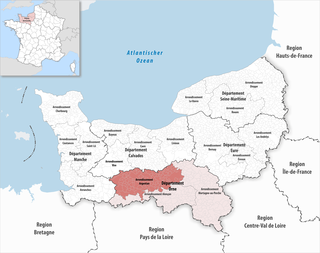
Tournai or Tournay is a city and municipality of Wallonia located in the Province of Hainaut, Belgium. It lies 89 km (55 mi) by road southwest of the centre of Brussels on the river Scheldt, and is part of Eurometropolis Lille–Kortrijk–Tournai, In 2022, the municipality of Tournai had an estimated population of 68,518 people.

Mont-Saint-Michel is a tidal island and mainland commune in Normandy, France.

Avranches is a commune in the Manche department, and the region of Normandy, northwestern France. It is a subprefecture of the department. The inhabitants are called Avranchinais.

The Treaty of Aix-la-Chapelle or Aachen ended the War of Devolution between France and Spain. It was signed on 2 May 1668 in Aachen. Spain acceded on 7 May 1669.
The 2000–2006 municipal reorganization in Quebec resulted in large-scale amalgamation of smaller municipalities in Quebec into larger cities. It was undertaken by one administration, and modified and partially undone by its successor.

Courmayeur is a town and comune in northern Italy, in the autonomous region of Aosta Valley.

The arrondissement of Avranches is an arrondissement of France in the Manche department in the Normandy region. It has 134 communes. Its population is 134,724 (2016), and its area is 1,888.2 km2 (729.0 sq mi).

The arrondissement of Argentan is an arrondissement of France, located in the Orne department, region of Normandy. It has 123 communes. Its population is 110,239 (2016), and its area is 1,904.1 km2 (735.2 sq mi).

La Chapelle-Saint-Aubert is a commune in the Ille-et-Vilaine department in Brittany in northwestern France.

Vielha e Mijaran is a municipality in central Aran, Catalonia. It is the capital and largest municipality of the region, with 5,581 inhabitants as of 2022. It is part of the terçons of Castièro and Marcatosa.

The former French Catholic Diocese of Noyon lay in the north-east of France, around Noyon. It was formed when Saint Medardus moved the seat of the bishopric at Vermandois to Noyon, in the sixth century. For four centuries it was united with the bishopric of Tournai as the Diocese of Noyon–Tournai. Then in the twelfth century it was again independent, and the bishop of Noyon became a pairie-comté of France.
The former French diocese of Thérouanne controlled a large part of the left bank of the river Scheldt during the Middle Ages. Territorially it was part of the county of Artois which belonged to the county of Flanders.

Tournai railway station is a railway station in Tournai, Hainaut, Belgium, situated on railway line 94. It is operated by the National Railway Company of Belgium (SNCB/NMBS).
Brasserie de Brunehaut is the trade name for Brunehaut brewery, located in Rongy-Brunehaut (Hainaut), Wallonia, 80 km south/southwest of Brussels, Belgium, near the French border.

Saint-Aubert is a municipality in Quebec, situated in the L'Islet Regional County Municipality and the Chaudière-Appalaches administrative region. Saint-Aubert lies in the Côte-du-Sud federal electoral district.

The Mont-Saint-Michel Abbey is an abbey located within the city and island of Mont-Saint-Michel in Normandy, in the department of Manche.

Putanges-le-Lac is a commune in the department of Orne, northwestern France. The municipality was established on 1 January 2016 by merger of the former communes of Chênedouit, La Forêt-Auvray, La Fresnaye-au-Sauvage, Ménil-Jean, Putanges-Pont-Écrepin, Rabodanges, Les Rotours, Saint-Aubert-sur-Orne and Sainte-Croix-sur-Orne.
The canton of Caudry is an administrative division of the Nord department, northern France. It was created at the French canton reorganisation which came into effect in March 2015. Its seat is in Caudry.
The canton of Argentan-2 is an administrative division of the Orne department, northwestern France. It was created at the French canton reorganisation which came into effect in March 2015. Its seat is in Argentan.

The Church of Saint Quentin is a Roman catholic parish church in Tournai, Belgium. The largely Romanesque building is located on the main square of the town, the Grand-Place. Known to have existed since the 10th century, the current building was built around 1200, but has been altered several times throughout history. In the late 15th century, a major reconstruction effort altered the chancel, created an ambulatory and replaced earlier side chapels. This reconstruction was partially financed by tapestry maker Pasquier Grenier and his wife Marguerite de Lannoye, who were also buried in one of the chapels. During World War II, the church was heavily damaged by German bombing in 1940 and subsequently reconstructed after the war. It opened again in 1968. The current facade and tower are reconstructions from this period. Inside, the church contains two Late Gothic wooden sculptures, made by Jean Delemer and painted by Robert Campin and dated to 1428. They are of art historical interest as early examples of such Late Gothic sculpture.
















